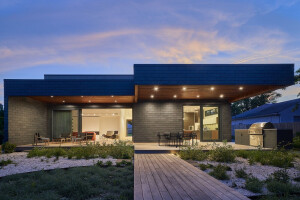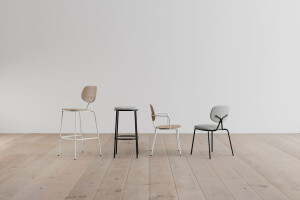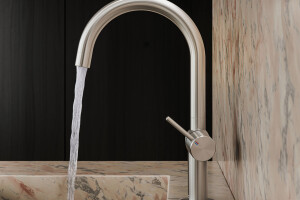The 1+1 Houses were designed as two distinct residences that share the same structural layout. In this project, the placement of concrete pillars and beams was fundamental in guiding the formal conception of the homes. The goal was to develop a design with an economical and unique structure, while also accommodating two different residences: a courtyard house and a house with a lateral setback. Although they are twin houses, the two residences were designed to embrace different possibilities.

House 1 features an internal courtyard that divides the TV room, dining room, and kitchen while integrating them when opened. The aim was for this home to prioritize the intimacy of its residents. The social areas were designed to open onto the internal courtyard, making this uncovered core a central integrative element on the ground floor. On the upper floor, the courtyard creates separation between the master suite and the two bedrooms that open toward the back of the lot, ensuring a significant degree of privacy for the future residents.

House +1 was designed to have a visual connection with the side garden that runs along the entire ground floor of the house, linking the backyard to the front garden. In this house, the spaces are more self-contained, with fewer connections between them, allowing for a different kind of appropriation by its residents compared to House 1.

The final volumetry of the houses consists of white solids resting on a concrete structure. These two volumes are connected by a planter that extends over the front setback, unifying the ensemble. The vegetation in these structures interrupts, through its horizontality, the purity of the form and transforms according to the seasons. The rear facade facing the backyard is framed by an element that contains the openings and the ventilation infrastructure, which includes the barbecue area.
All openings in the houses were designed to ensure adequate lighting, positioned on the east, west, and north facades of the residences.

The vertical circulations were conceived as transitional moments between social and private spaces. The staircase and the first-floor hallway were designed to create a more intimate atmosphere, interrupted only by a narrow beam of light from vertical openings facing the internal courtyard or the lateral setback, respectively, in Houses 1 and +1. The goal is for residents to experience small transitional moments stimulated by the spaces themselves. Light is abundant and always present in the social areas but is directed and channeled in the transitional spaces leading to the private areas.

Finally, the architecture of the houses is the result of the free appropriation by the residents, encouraged by the flexible spaces designed to adapt to different needs. The 1+1 Houses were designed to accommodate various ways of living without compromising the basic principles of well-thought-out architecture: economical, simple, and well-suited to its terrain.











































